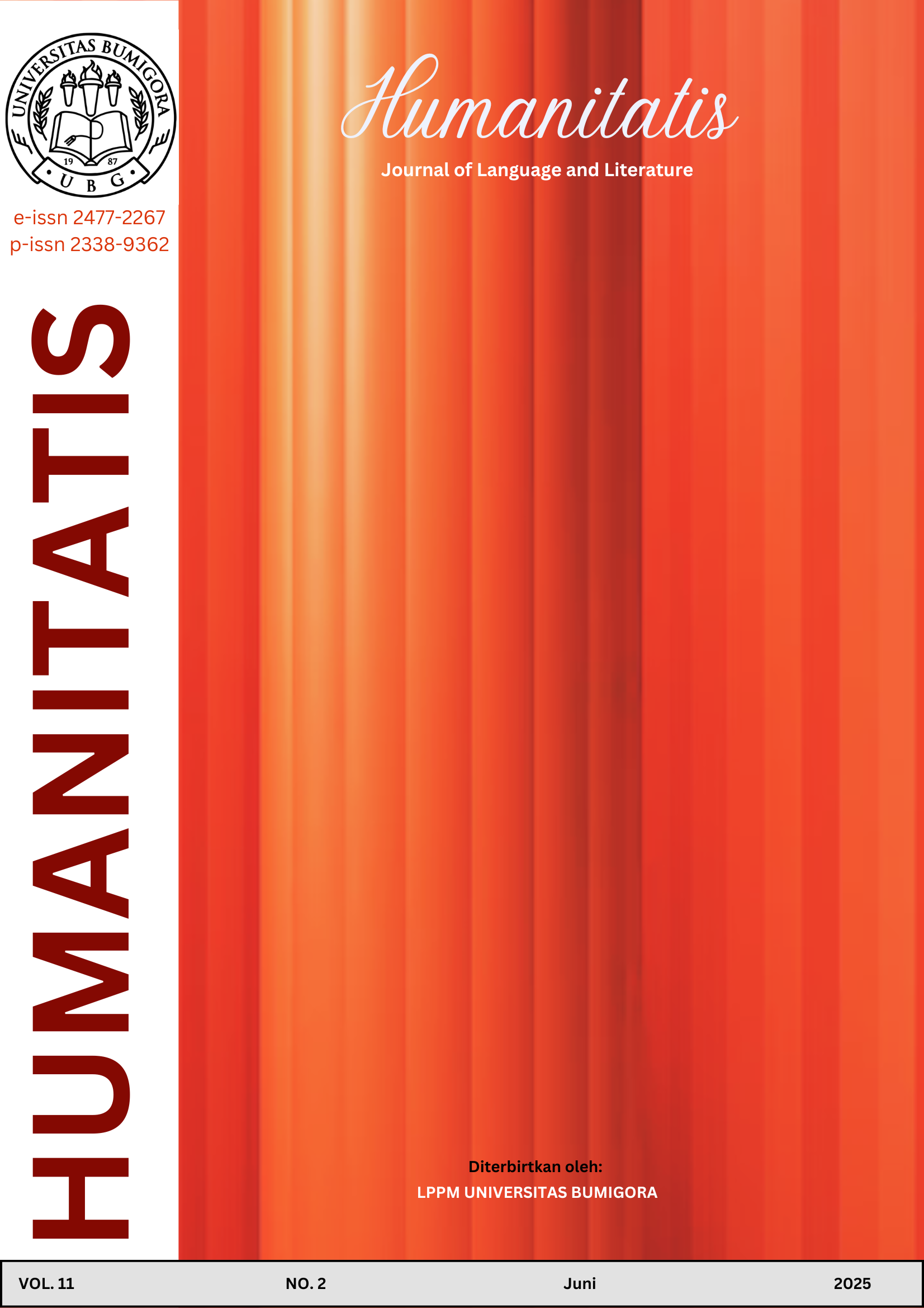A Psychological Study of the Main Character in the Seher Movie: Sigmund Freud Perspective
DOI:
https://doi.org/10.30812/humanitatis.v11i2.5054Keywords:
Psychological Study, Seher Movie, Sigmund Freud PerspectiveAbstract
This study examines Burhan’s psychological transformation in the movie “The Vengeance of Seher” using the psychoanalytic theory of Sigmund Freud’s Id, Ego, and Superego. Qualitative descriptive research was applied with the information gathered from dialogue or sentences regarding the movie’s main figure. The results of the study showed that the psychological pressure and rejection that the main figure received made the Id’s urge more dominant, causing him to take a shortcut by using black magic. His inability to control his inner conflict pushed him towards destructive actions, ultimately negatively impacting him and those around him. The film Seher not only presents horror elements, but also depicts how psychological disorders can affect a person’s behavior. Furthermore, this investigation provides insight into the importance of balance between the Id, Ego, and Superego in managing emotional stress. This study suggests that by comprehending fictional characters’ psychological aspects, audiences could become more aware of mental health concerns and emotional control. This study suggests that by comprehending the psychological aspects of fictional characters, the audience could grow more aware of mental health concerns and emotional control. Moreover, this research recommends additional studies employing different psychological techniques in addition to audience reaction analysis.
References
Afandi, A. (2018). Kepercayaan Animisme-Dinamisme SertaAdaptasi Kebudayaan Hindu-Budha Dengan Kebudayaan Asli Di Pulau Lombok-Ntb. Historis | FKIP UMMat, 1(1), 1. https://doi.org/10.31764/historis.v1i1.202
Amora, I. (2025). Seher, Fenomena Ilmu Hitam di Lombok Akibat Cinta Ditolak.
Anggraeni, P., Januarius, M., & Ahmad, S. (2019). The Implementation of Transposition Translation Procedures in English-Indonesian Translation of Epic Movie Subtitle. Journal of English Language Teaching, 7(2), 1–7.
Arda, B., & Kanten, P. (2023). A Qualitative Research on the Determination of Toxic Personality Traits. Istanbul Management Journal, 0(94), 28–36. https://doi.org/10.26650/imj.2023.94.003
Ayar, M. Z., & Demir, F. (2022). A Study of Freudian Psychological Factors Related To the Suicide of the Main Character in Paulo Coelho’s Veronika Decides To Die. Erciyes Akademi, 36(3), 1446–1461. https://doi.org/10.48070/erciyesakademi.1131365
Bronkhorst, J. (2022). Mystical Experience. Religions, 13(7). https://doi.org/10.3390/rel13070589
Corbita, D. P., & Saministrado, M. L. S. (2019). The Supernatural in Contemporary Philippine Horror Films. Journal of Humanities and Social Sciences Studies (JHSSS), 48–81.
Feist, J., & Feist, G. J. (2008). Theories of Personality (7th ed.). McGraw Hill Higher Education.
Furidha, B. W. (2023). Comprehension of the Descriptive Qualitative Research Method: A Critical Assessment of the Literature. ACITYA WISESA: Journal of Multidisciplinary Research, 2(4), 1–8.
Goodwin, J., Saab, M. M., Dillon, C. B., Kilty, C., McCarthy, A., O’Brien, M., & Philpott, L. F. (2021). The Use of Film-Based Interventions in Adolescent Mental Health Education: A Systematic Review. Journal of Psychiatric Research, 137(February), 158–172. https://doi.org/10.1016/j.jpsychires.2021.02.055
Halimah, N. (2021). The Qur’an and the Reading Witchcraft: Study on the Use of Qur’an Verses in the Siccin 1 Film. MUṢḤAF Jurnal Tafsir Berwawasan Keindonesiaan, 2(1), 103–124. https://doi.org/10.33650/mushaf.v2i1.3343
Hall, S., & Liebenberg, L. (2024). Qualitative Description as an Introductory Method to Qualitative Research for Master’s-Level Students and Research Trainees. International Journal of Qualitative Methods, 23, 1–5. https://doi.org/10.1177/16094069241242264
Huda, A. S., Nafsika, S. S., & Salman, S. (2023). Film Sebagai Media dalam Mengubah Cara Pandang Manusia dalam Prinsip Kemanusiaan. Irama: Jurnal Seni Desain Dan Pembelajarannya, 5(1), 9–14.
Humairah, A. A., & Abdullah, A. (2022). A Comparative Study of Supernatural Events Between Kimi No Nawa and Tenki No Ko. ELITERATE: Journal of English Linguistics and Literature Studies, 2(2), 2022.
Humpal, T. (2023). Contemporary Korean Religious Horror: Cults, Conspiracy, and Korean Cinema’s “Syncretic Panic”. Journal of Korean and Asian Arts, 6, 63–86. https://doi.org/10.20976/KAA.2023.6.003
James, N., Watts, A., Roazzi, A., & Formoso, K. A. (2024). Psychology of Mystical Experience. Zenodo, 1–20. https://doi.org/10.5281/zenodo.13691331
Junika, N., Razzaq, A., & Assoburu, S. (2025). Analisis Semiotika Ronal Barthes Pada Film Siksa Kubur Karya Joko Anwar Tahun 2024. Jurnal Desain Komunikasi Visual, (1), 1–10.
Kamma, V., Natsir, M., & Lubis, I. (2023). An Analysis of Katie’s Personality in Midnight Sun Film. Ilmu Budaya: Jurnal Bahasa, Sastra, Seni, dan Budaya, 7(3), 1043–1054.
Liu, X. (2023). Shamanic Culture’s Reconnection of Earth and Heaven (Xu Ditiantong) in the New Era in China: The Dialectical Relationship Between Material Civilization and Cultural Intimacy. Religions, 14(4). https://doi.org/10.3390/rel14040500
Maisari, L., Rinaldi, R., & Rinaldi, R. (2024). Trauma and Its Impact in Aury Wallington’s Spirit Untamed Movie. MORPHOSIS: Journal of Literature, 6(1), 32–38.
Olivia Ihueze, A., & Chidimma Blessing, I. (2024). The Knife: A Psychoanalytic Exploration of Toxic Inheritance in My Sister, the Serial Killer. International Journal on Studies in English Language and Literature, 12(7), 1–6. https://doi.org/10.20431/2347-3134.1207001
Rhosid, A., & Sumarlan, I. (2023). Analysis of Moral Value in Short Film Pulang by Galih Firdaus. Symposium of Literature, Culture, and Communication (SYLECTION), 3(1), 1156. https://doi.org/10.12928/sylection.v3i1.14155
Salmanuddin, & Munir, A. (2023). Fenomena Ilmu Hitam Pangarasa Dalam Kehidupan Sosial Masyarakat Di Desa Kauman Selatan Kecamatan Rao Selatan Kabupaten Pasaman. JIABIS: Jurnal Ilmu Administrasi Bisnis dan Sosial, 1(1), 75–87.
Sheryl Norifly Loway, & Nurochman. (2023). An Analysis of Id, Ego, and Superego By Sigmund Freud Through Kat Stratford’s Character in 10 Things I Hate About You Movie. Jurnal Sosial Humaniora dan Pendidikan, 2(1), 07–10. https://doi.org/10.56127/jushpen.v2i1.517
Silooy, C. V. (2023). Perdukunan, Sihir, Dan Ragamnya: Sebuah Upaya Untuk Memahami Praktik Rahasia Dalam Narasi-Narasi Kisah Para Rasul. Phronesis: Jurnal Teologi dan Misi, 6(1), 81–99. https://doi.org/10.47457/phr.v6i1.338
Sparkes, B. H. (2014). Playing with the Devil: Adolescent Involvement with the Occult, Black Magic, Witchcraft and the Satanic to Manage Feelings of Despair. (February).
Subagiyo, D. N., & Sumayah. (2025). Jo March’s Effort for Equality in The Little Women Film: A Utilitarianism Perspective. Surakarta English and Literature Journal, 8(1), 55–69.
Sulaiman, Y., & Sule, M. M. (2023). Sorcery and Its Menace Among Muslims: Islamic Da’wah in Perspective. Wahana Akademika: Jurnal Studi Islam dan Sosial, 10(1), 1–16. https://doi.org/10.21580/wa.v10i1.14958
Wahyudin, D. (2018). Identitas Orang Sasak: Studi Epistemologis Terhadap Mekanisme Produksi Pengetahuan Masyarakat Suku Sasak. Jurnal Penelitian Keislaman, 14(1), 52–63. https://doi.org/10.20414/jpk.v14i1.493
Yusof, A. M., Satkunananthan, A. H., Hashim, R. S., & Rusli, N. M. (2021). The Figure of the Nenek Kebayan and the Witch in Selected Haunted House Films. 3L: Language, Linguistics, Literature, 26(4), 87–98. https://doi.org/10.17576/3L-2020-2604-07
Downloads
Published
Issue
Section
License
Copyright (c) 2025 Budi Setiawan, Naharudin, Zamroni Ramdan, Baiq Nuri Humairo

This work is licensed under a Creative Commons Attribution 4.0 International License.
















